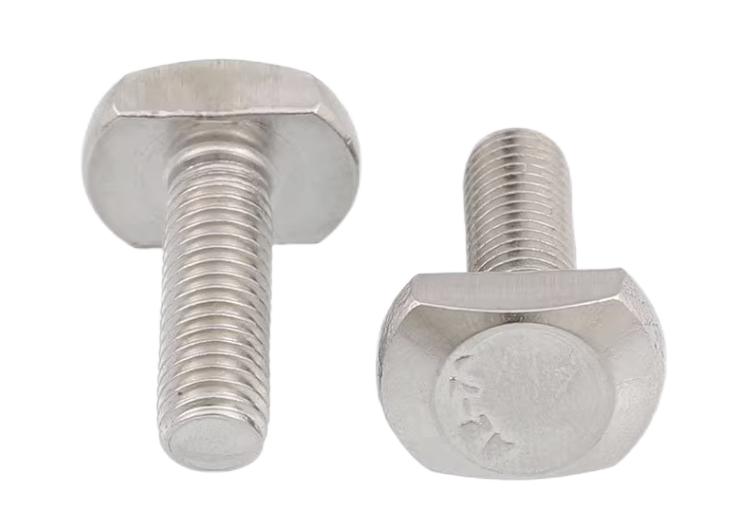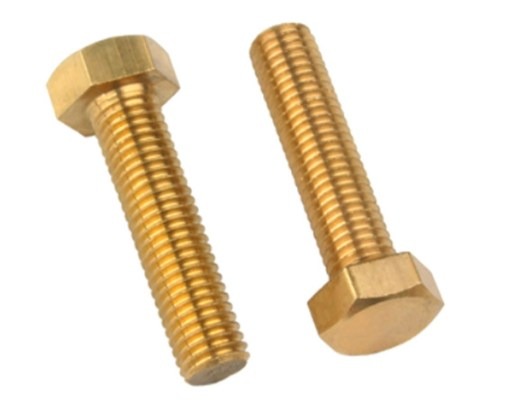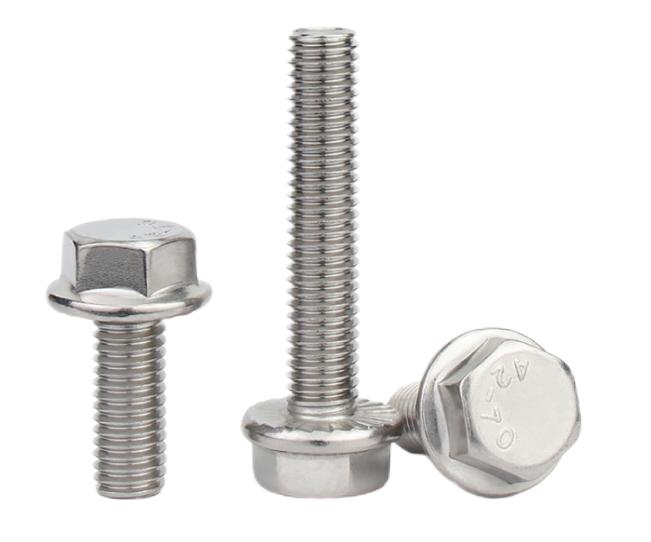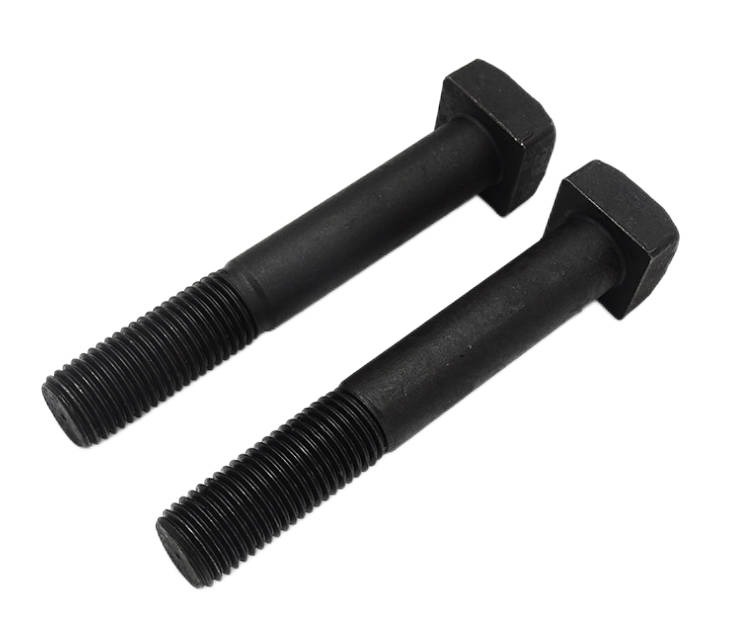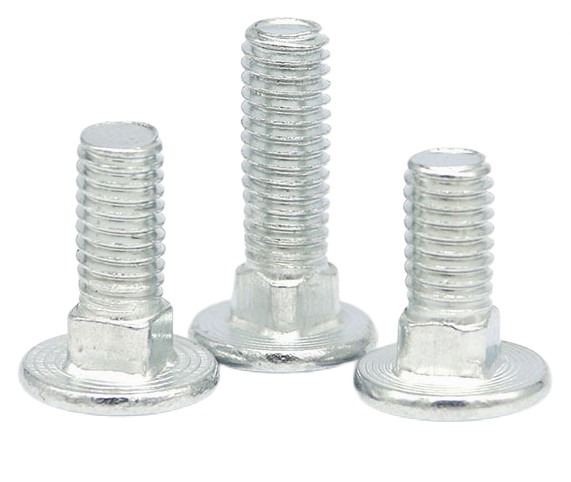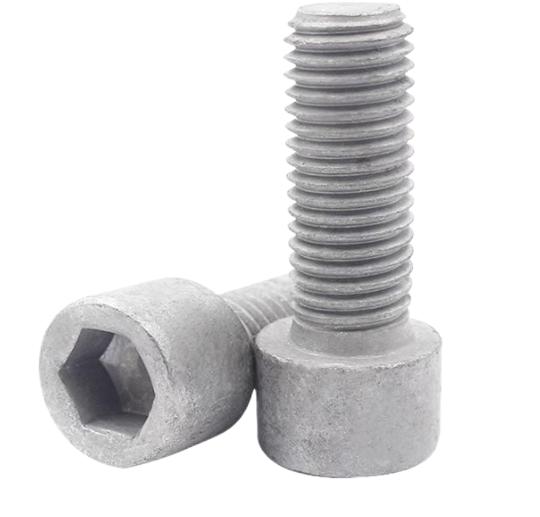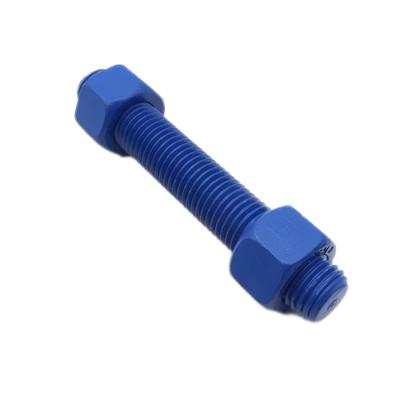Surface Treatment of Bolts: Enhancing Performance and Durability
Bolts, a crucial component in various construction and assembly applications, are often exposed to harsh environments that can compromise their integrity. Surface treatment plays a vital role in protecting bolts from corrosion, wear, and other forms of degradation, thereby ensuring their functionality and extending their lifespan. This article explores various bolt surface treatment methods, delving into their individual processes, benefits, and applications.

1. Oxidation and Blackening
Oxidation is a chemical reaction that occurs when the surface of the bolt interacts with oxygen at a high temperature. During this process, the outermost layer of the bolt’s metal atoms loses electrons and combines with oxygen atoms, forming a thin layer of oxide on the bolt’s surface. This oxide layer typically appears brown or black in color and offers a modest level of protection against corrosion in environments with slightly aggressive conditions.
The oxidation process is achieved by heating the bolts in a controlled atmosphere, such as a furnace or oven, at specific temperatures and for a predetermined duration. The precise temperature and duration depend on two key factors:
- Desired Oxide Layer Thickness: A thicker oxide layer generally provides better corrosion resistance, but it can also affect the mechanical properties of the bolt by making it slightly more brittle. Therefore, finding the optimal thickness is crucial for balancing corrosion protection with desired mechanical performance.
- Material of the Bolt: Different bolt materials react differently to oxidation. The specific temperature and duration settings must be adjusted based on the material composition to ensure proper oxide layer formation without damaging the underlying metal.
Blackening: Building Upon Oxidation for Enhanced Protection
Blackening is a treatment that builds upon the foundation laid by oxidation to further enhance the corrosion resistance properties of the oxide layer. This process involves immersing the already oxidized bolts in a specific chemical solution containing phosphates, nitrates, or sulfides. These chemicals react with the existing oxide layer, converting it into a more complex and protective layer. This new layer, often appearing black, offers a superior level of corrosion resistance compared to simple oxidation.
Blue-black Treatment: Combining Functionality with Aesthetics
A specific variant of the blackening process is the blue-black treatment. This technique involves applying particular chemical solutions to the oxidized bolts, resulting in a distinctive blue-black appearance. While it offers slightly better corrosion resistance compared to standard blackening, the primary purpose of this treatment is often aesthetic. The unique blue-black finish can enhance the visual appeal of the bolts, making them suitable for applications where both functionality and appearance are important.
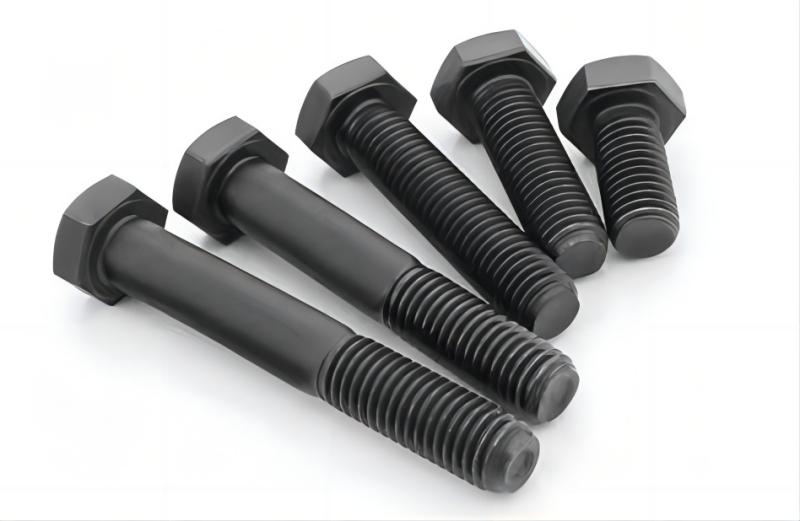
2. Phosphate Treatment
Phosphating is a surface treatment process that chemically transforms the surface layer of the bolt into a microporous layer composed of phosphate crystals. This conversion is achieved by immersing the bolts in a solution containing phosphoric acid as the primary component. Additionally, other chemicals like zinc or manganese are often incorporated into the solution to further enhance the properties of the phosphate layer.
The phosphating process unfolds in several key steps:
- Preparation: The bolts are thoroughly cleaned and degreased to remove any contaminants that could hinder the phosphating reaction.
- Immersion: The cleaned bolts are submerged in the phosphoric acid solution at a controlled temperature for a predetermined duration. During this stage, the chemical reaction between the acid and the bolt’s surface takes place, leading to the formation of phosphate crystals.
- Rinsing: After the desired reaction time, the bolts are removed from the solution and thoroughly rinsed with water to remove any residual acid.
- Drying: The rinsed bolts are then dried completely to prevent any moisture from being trapped within the micropores of the phosphate layer.
The resulting phosphate layer offers several advantages for bolts:
- Improved Adhesion: The microporous structure of the phosphate layer creates an ideal surface for paint or other coatings to adhere to. This enhanced adhesion ensures that the protective coating stays securely bonded to the bolt, even under harsh conditions.
- Enhanced Corrosion Resistance: While not as robust as some other methods, the phosphate layer provides a mild level of corrosion resistance. This added protection is particularly beneficial in environments with slightly corrosive elements.
- Improved Lubrication: The micropores within the phosphate layer can act as tiny reservoirs for lubricants. This characteristic helps reduce friction and wear during the assembly and disassembly of bolts, making the process smoother and minimizing potential damage to the threads.
Importance of Applying Anti-rust Oil: A Complementary Protection Layer:
Similar to oxidation and blackening treatments, applying a coat of anti-rust oil after phosphating is highly recommended. This additional step offers several benefits:
- Fills Micropores: The anti-rust oil fills the micropores of the phosphate layer, acting as a physical barrier against moisture and corrosive elements. This further enhances the overall corrosion resistance of the treated bolt.
- Improves Lubrication: The oil adds an extra layer of lubrication, further reducing friction and wear during assembly and disassembly, complementing the inherent lubricating properties of the phosphate layer itself.
- Enhances Long-Term Performance: By providing an additional layer of protection, anti-rust oil helps to extend the lifespan of the phosphate bolt and maintain its functionality over time.
Therefore, while phosphating offers valuable benefits on its own, combining it with the application of anti-rust oil creates a synergistic effect, providing a more comprehensive and long-lasting protective solution for bolts.
Applications of Phosphate Bolts
Phosphate bolts offer a valuable combination of affordability, mild corrosion resistance, and improved lubrication, making them suitable for a wide range of applications. Here are some key areas where phosphate bolts find common use:
1. Construction Industry
- Interior applications: Due to their moderate corrosion resistance and affordability, phosphate bolts are often used in various interior construction projects, such as drywall installation, cabinet assembly, and furniture building.
- Temporary or non-critical applications: For temporary structures or applications where long-term exposure to harsh environments is not expected, phosphate bolts can provide adequate functionality at a lower cost compared to other corrosion-resistant options.
2. Manufacturing and Assembly
- General assembly: Phosphate bolts are commonly used in general assembly applications where mild corrosion resistance and improved lubrication are beneficial, such as attaching components within housings or assembling non-critical machinery parts.
- Applications requiring temporary protection: In situations where components might experience temporary exposure to moisture or mild corrosive elements during storage or transportation, phosphate bolts can offer a cost-effective layer of protection before the final assembly or application.
3. Automotive Industry
- Interior components: Similar to their use in construction, phosphate bolts often find application in various interior components of automobiles, such as seat frames, dashboard panels, and trim pieces.
- Non-critical applications: For certain non-critical applications within a vehicle, such as attaching interior panels or non-structural components, phosphate bolts can provide adequate functionality at a reasonable cost.
4. Home Improvement and DIY Projects
- General repairs and maintenance: Due to their widespread availability and affordability, phosphate bolts are frequently used for various home improvement and DIY projects, such as furniture repair, appliance installation, or general household repairs.
- Applications with limited exposure: When addressing tasks with limited exposure to moisture or mild corrosive elements, phosphate bolts can offer an adequate level of protection while remaining cost-effective.
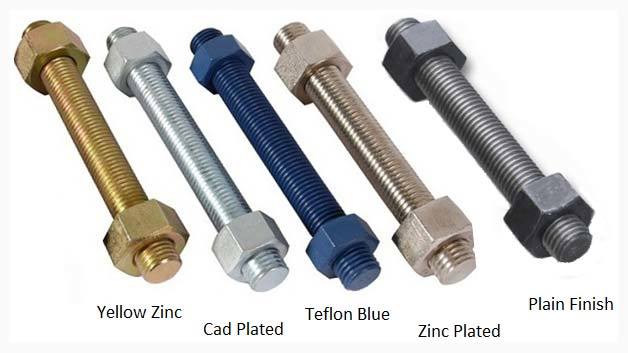
3. Plating
Electroplating is a widely used surface treatment technique that utilizes an electrical current to deposit a thin layer of metal onto the surface of a bolt. This process creates a metallic coating that offers various advantages, including:
- Enhanced Corrosion Resistance: The deposited metal layer acts as a barrier, preventing the underlying bolt material from coming into direct contact with corrosive elements, significantly improving its resistance to rust and other forms of degradation.
- Improved Appearance: Depending on the chosen metal, electroplating can provide a visually appealing finish, enhancing the aesthetics of the bolt.
- Increased Functionality: Some plated metals offer additional benefits like improved wear resistance, electrical conductivity, or increased hardness, depending on the specific application.
Various metals can be used for electroplating bolts, each offering unique properties and applications:
A. Electro-zinc Plating: Cost-Effective and Versatile
Electro-zinc plating is the most common and cost-effective method for plating bolts. During this process, a thin layer of zinc is deposited onto the bolt’s surface. Zinc offers superior corrosion resistance compared to oxidation, blackening, and phosphating, making it suitable for a wide range of applications, including:
- Construction: Zinc-plated bolts are commonly used in construction due to their affordability and adequate protection against corrosion in most environments.
- Automotive: Many automotive components, such as brackets and fasteners, utilize zinc-plated bolts due to their balance of cost, performance, and aesthetics.
- Appliance Industry: Zinc plating offers a good balance of functionality and appearance, making it a suitable choice for various appliance components.
B. Chrome Plating: Aesthetics with Corrosion Resistance
Chrome plating provides a visually appealing and highly corrosion-resistant finish. However, it’s important to note that this process can slightly alter the mechanical properties of the bolt, making it less suitable for high-strength applications where maintaining the original strength is crucial. Chrome plating is commonly used for bolts in applications where:
- Aesthetics are a Priority: Chrome’s bright and shiny finish is often desired for applications where visual appeal is important, such as decorative hardware or certain automotive components.
- Mild Corrosion Resistance is Needed: Chrome plating offers good protection against corrosion in environments with moderate levels of corrosive elements.
C. Nickel Plating: Enhance Corrosion Resistance and Strength
Nickel plating offers a combination of good corrosion resistance and wear resistance. Additionally, compared to other plating methods, it can improve the hardness and overall strength of the bolt. However, nickel plating can be more expensive than other options. This method finds applications in industries where these properties are critical, such as:
- Marine: Nickel plating offers good corrosion resistance in the harsh saltwater environment, making it suitable for marine applications.
- Aerospace: The combination of wear resistance and strength makes nickel plating a viable option for certain aerospace components.
- Electronics: Nickel’s good electrical conductivity and corrosion resistance can be beneficial for certain electronic components.
D. Silver Plating: Prioritizing Conductivity at a Premium
While uncommon for bolts due to its high cost, silver plating offers exceptional electrical conductivity and corrosion resistance. This method is primarily used in specific electrical applications where:
- High Electrical Conductivity is Essential: Silver’s superior conductivity makes it the preferred choice for electrical components where efficient current flow is critical.
- Corrosion Resistance is Crucial: Silver’s excellent corrosion resistance ensures long-lasting performance in environments with harsh elements.
By understanding the unique properties and applications of each plating method, choosing the most suitable option for a specific bolt application becomes a more informed decision.
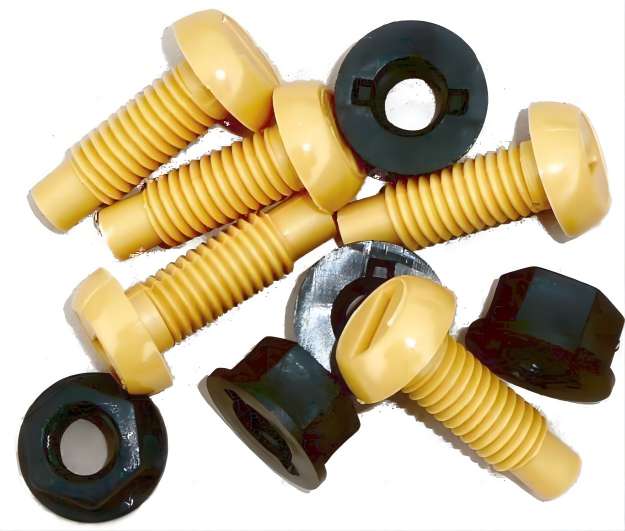
4. Hot Dip Galvanization
Hot dip galvanization is a surface treatment process that utilizes a high temperature and a molten zinc bath to provide exceptional corrosion resistance to bolts. This method involves the following steps:
- Preparation: The bolts are thoroughly cleaned and degreased to remove any contaminants that could hinder the zinc coating’s adhesion.
- Fluxing: The cleaned bolts are dipped in a liquid flux solution, typically composed of zinc chloride or ammonium chloride. This flux acts as a cleaning agent, removing any remaining surface oxides and ensuring a strong bond between the zinc and the bolt’s metal.
- Immersion: The bolts are then submerged completely into a molten zinc bath maintained at a high temperature, typically around 450°C (842°F).
- Reaction and Coating Formation: During immersion, a metallurgical reaction occurs at the interface between the molten zinc and the bolt’s surface. This reaction leads to the formation of several distinct layers, including an iron-zinc alloy layer and a pure zinc outer layer. The total thickness of the coating can vary depending on factors like immersion time and the specific metal composition of the bolt.
- Cooling and Inspection: After a predetermined immersion time, the bolts are removed from the molten zinc bath and allowed to cool at room temperature. The cooled bolts are then inspected to ensure the coating is uniform, free of defects, and meets the desired thickness specifications.
The resulting hot dip galvanized coating offers several advantages for bolts:
- Excellent Corrosion Resistance: The thick and robust zinc layer acts as a physical barrier, effectively preventing the underlying bolt material from coming into contact with corrosive elements. This makes hot dip galvanized bolts well-suited for harsh environments with high levels of moisture, salt, and other corrosive elements.
- Long-lasting Protection: The hot dip galvanized coating provides long-term protection against corrosion, extending the lifespan of the bolts and reducing the need for frequent replacements.
- Durability: The zinc coating also offers a degree of protection against mechanical damage and wear, further enhancing the overall durability of the bolts.
Due to these advantages, hot dip galvanized bolts are widely used in various applications where excellent corrosion resistance is crucial, including:
- Outdoor Applications: Hot dip galvanized bolts are a popular choice for outdoor structures, such as bridges, fences, and railings, as they can withstand harsh weather conditions.
- Construction: Construction projects often utilize hot dip galvanized bolts due to their affordability, durability, and long-lasting corrosion resistance.
- Marine Environments: The exceptional corrosion resistance of hot dip galvanized bolts makes them well-suited for marine applications, such as boats, docks, and offshore structures, where they can withstand the harsh saltwater environment.
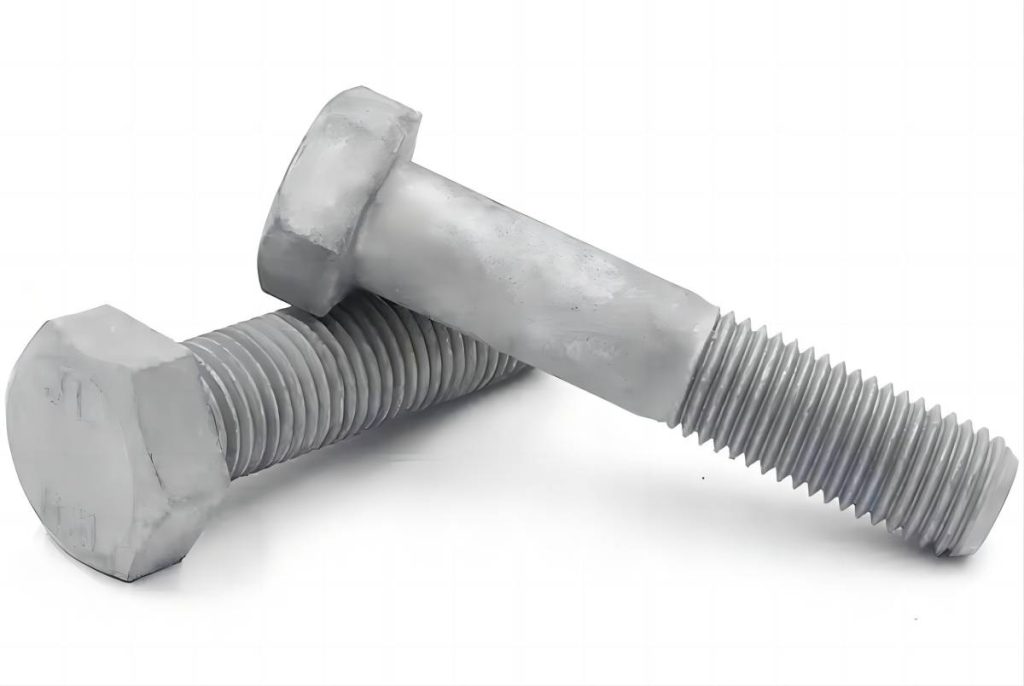
5. Zinc Infiltration
Zinc infiltration is a relatively new and innovative method that offers a sustainable solution for enhancing the corrosion resistance of bolts. Unlike traditional hot dip galvanization, this process doesn’t involve a molten zinc bath. Instead, it utilizes a controlled gaseous environment to diffuse zinc atoms into the surface layer of the bolt material. This diffusion process creates a thin and uniform layer of zinc-iron alloy, offering excellent protection against corrosion.
Here’s a breakdown of the zinc infiltration process:
- Preparation: Similar to hot dip galvanization, the bolts are meticulously cleaned and degreased to ensure a clean surface for optimal zinc diffusion.
- Packing: The cleaned bolts are placed in a container along with a zinc-releasing agent, often in the form of a powder or paste. This agent serves as the source of zinc atoms for the diffusion process.
- Heat Treatment: The container with the bolts and zinc-releasing agent is then subjected to a controlled heat treatment in a furnace. During this stage, the temperature is precisely maintained to facilitate the diffusion of zinc atoms from the agent into the surface layer of the bolt material.
- Diffusion and Alloy Formation: As the temperature rises, the zinc-releasing agent begins to decompose, releasing zinc atoms. These free zinc atoms then diffuse into the outermost layer of the bolt material, forming a microscopic zinc-iron alloy layer. The specific thickness and composition of this alloy layer are precisely controlled by factors like the temperature, duration of the heat treatment, and the type of zinc-releasing agent used.
- Cooling and Inspection: After the predetermined heat treatment time, the container is cooled back to room temperature. The bolts are then inspected to ensure the zinc-iron alloy layer is uniform, free of defects, and meets the desired thickness specifications.
The zinc infiltration process offers several advantages for bolts:
- Excellent Corrosion Resistance: Despite being thinner than a hot dip galvanized coating, the zinc-iron alloy layer formed through infiltration provides excellent protection against corrosion, making it suitable for various environments.
- Environmentally Friendly: Unlike hot dip galvanization, which utilizes a large volume of molten zinc, the zinc infiltration process eliminates the need for such a bath. This translates to reduced energy consumption and a lower environmental impact.
- Uniform and Consistent Coating: The controlled diffusion process allows for a more uniform and consistent zinc-iron alloy layer compared to hot dip galvanization, where variations in coating thickness can sometimes occur.
- Thin and Flexible Coating: The thinness of the zinc-iron alloy layer makes it more flexible compared to thicker hot dip galvanized coatings. This flexibility can be beneficial for applications where the bolts experience slight bending or movement.
Due to these advantages, zinc infiltration is gaining popularity as a sustainable and effective method for enhancing the corrosion resistance of bolts, particularly in applications where environmental considerations are a priority.
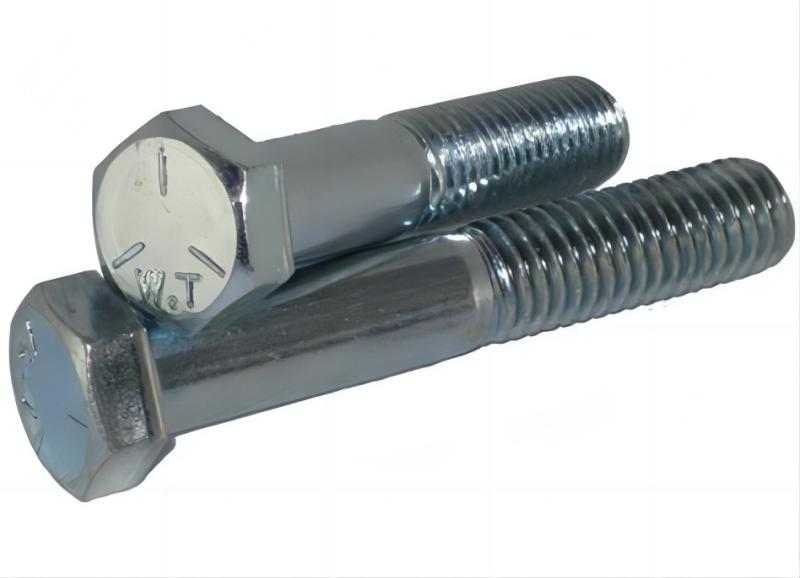
6. Electroless Zinc Flake Coating
Electroless zinc flake coating, also known as Dacromet coating and lamellar coating offers a unique method for enhancing the surface protection of bolts. Unlike electroplating, which relies on an electrical current, this process utilizes a chemical reaction to deposit a layer of zinc flakes onto the bolt’s surface. These zinc flakes are typically mixed with other elements like chromium or aluminum, creating a composite coating with specific properties tailored to different application needs.
Key Characteristics of Electroless Zinc Flake Coating
- Chemical Reaction-Based Process: Instead of electricity, a chemical reaction involving the immersion of bolts in a specific solution triggers the deposition of zinc flakes. This eliminates the need for complex electrical equipment, making the process simpler and potentially more adaptable for various production settings.
- Composite Coating Composition: The zinc flakes used in this method are often combined with other elements like chromium or aluminum. These additional elements improve the overall characteristics of the coating, offering enhanced properties beyond those of pure zinc.
- Multilayered Structure: The deposited layer consists of numerous microscopic zinc flakes, creating a layered or lamellar structure. This unique structure provides several benefits, including improved adhesion to the bolt’s surface and enhanced resistance to corrosion and wear.
Types of Dacromet Coatings
Dacromet is a widely recognized brand of electroless zinc flake coating that utilizes a combination of zinc, chromium, and sometimes additional elements like aluminum. Two primary types of Dacromet coatings offer specific advantages for various applications:
1. Zinc-Chromium Coating
- Excellent Corrosion Resistance: This coating excels in protecting bolts against corrosion, even in harsh environments with high humidity, salt spray, or other corrosive elements.
- UV Resistance and Heat Resistance: The zinc-chromium coating exhibits good resistance to ultraviolet radiation and elevated temperatures, making it suitable for outdoor applications and environments with moderate heat exposure.
- Versatility: Due to its combined properties, the zinc-chromium coating finds applications in various sectors, including automotive components, outdoor furniture, and construction equipment.
2. Zinc-Aluminum-Chromium Coating
- Enhanced Corrosion Resistance: Similar to the zinc-chromium variant, this coating provides excellent protection against corrosion.
- Improved Wear Resistance: The inclusion of aluminum in this coating enhances its resistance to wear and tear, making it suitable for applications where bolts experience frequent friction or movement.
- Self-Lubricating Properties: The zinc-aluminum-chromium coating exhibits self-lubricating characteristics, which can reduce friction and wear during assembly and disassembly, particularly beneficial for moving parts and threaded fasteners.
- Applications: This variant finds favor in industries like agriculture, where machinery experiences high wear and tear, and in applications involving threaded fasteners for moving parts, where its self-lubricating properties offer additional advantages.
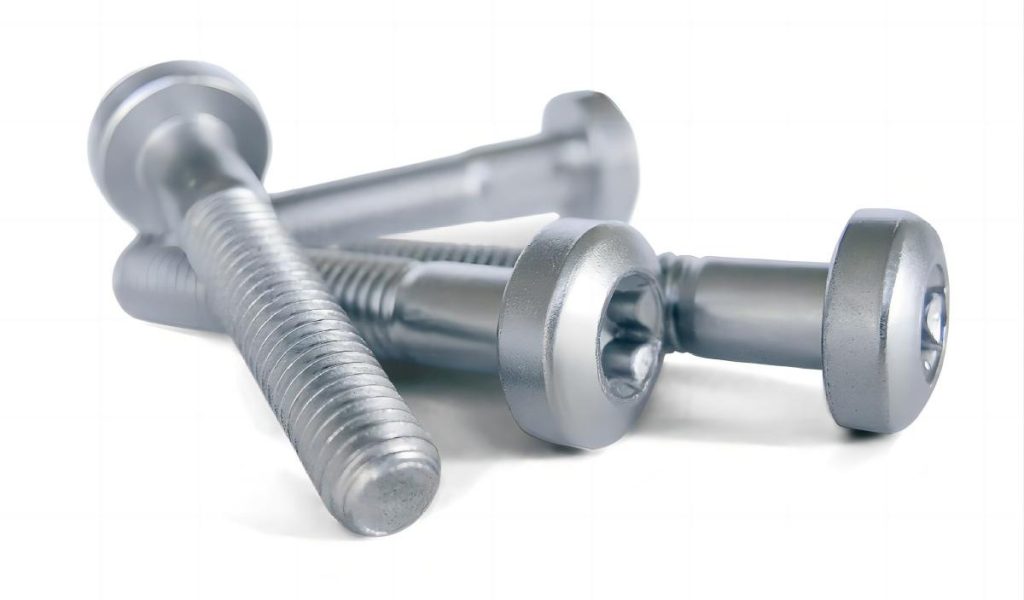
Conclusion
Surface treatment plays a crucial role in enhancing the performance and durability of bolts. Choosing the appropriate treatment method depends on various factors, including the intended application, environmental conditions, desired level of corrosion resistance, and cost considerations. Oxidation, blackening, and phosphating offer cost-effective options for mild environments. Electroplating methods like zinc and nickel plating provide excellent corrosion and wear resistance for various applications. Hot dip galvanizing and zinc infiltration offer superior protection in harsh environments. Finally, electroless zinc flake coatings, particularly Dacromet, provide a versatile and environmentally friendly option with excellent corrosion and wear resistance properties. Understanding these various methods and their unique advantages allows for informed decision-making when selecting the most suitable surface treatment for your specific bolting needs.

